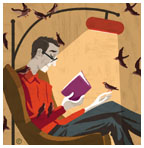
|
February 15, 2006: On the Campus
Illustration by Pep Montserrat, photo below by Celene Chang '06 |
Frisky roommates
By Amy Sennett ’06
Not since 1924, when a tiger captured in India by the father of football player Red Howard ’25 arrived with his handler by taxi from New York, has the campus enjoyed a living mascot. Because of his insatiable appetite for choice beef, that cat became something of a white elephant. After a couple of months and a few public appearances, the tiger was given to a nearby zoo, and since then only marble and stone incarnations of the emblematic beast have adorned campus architecture.
However, a zoo’s worth of other animals — some welcome, some not — is challenging the tiger’s position as king of the Jersey jungle.
An EEB major, notorious for his love of animals, raised a baby squirrel named Louis Rhinoceros in his dorm room for much of his sophomore year. This fall, he became the “proud father” of two baby zebra finches that he bred from his birds, John and Mary.
The student questioned the need for the University policy that bans pets — other than fish in tanks not exceeding 10 gallons — in dormitories. “Trust students to do what’s right and let them enjoy the therapeutic bond between man and beast that, when living on a college campus, can really only be discovered through a pet,” he said.
One senior Spanish major is building that bond with a pair of dwarf hamsters, Mufasa and Patchouli, purchased from a pet store on Route 1. Only three inches in length, the hamsters have become an endless source of entertainment for their owner, who sometimes incorporates them into games of hide-and-seek in her room.
“It makes your dorm feel a little more homey,” said the hamsters’ owner. “Having a hamster on your belly is almost as nice as curling up with your cat in front of the TV.”
Looking for a new hobby last fall, one senior history major established a 30-gallon salt-water aquarium in his room. His reef community includes a one-spot foxface, a clownfish, two starfish, three shrimp, clams, hermit crabs, and a pirate-skeleton figurine.
Costs for the tank, pumps, filters, lamps, and coral rock exceeded $400, and the student often spends an hour a day on maintenance. After conducting the necessary research online, he even created a “hospital tank” to nurse his sick clownfish back to health.
He maintains that the relaxation he feels while watching his “ecosystem” is worth the investment. “They know who you are and when you’re around,” he said of his fish. “They get into position for their feeding.”
Because of the University policy prohibiting pets, however, most owners must take elaborate measures to hide the existence of their pets from Princeton’s fire safety inspectors. (A University spokeswoman said that there have been “a few” violations over the last two years for which students were fined and required to remove their pets.) For a senior in Spelman Hall and her kitten, Amadeus, the result has been a game of cat and mouse.
“One morning I woke up to a fire inspector at my door and had to shove him [the kitten] under the blankets with me,” she said. “Of course he was squirming around like crazy while I explained that the litter box belonged to my ‘crazy mother’ who visited with her cat twice a week.”
Despite the fact that Amadeus had mistaken her bed for his litter box one recent afternoon, his owner admits she cannot get enough of him.
“He’s my buddy,” she said, laughing as Amadeus hid under a mattress pad on her bed. “I talk to my cat all day long. I’m obsessed.”
Not all members of the animal kingdom are quite so welcome inside Princeton’s dorm rooms. The squirrels that overpopulate campus, subsisting on hearty diets of Frist pizza crusts, might now be considered the school’s unofficial mascot. Room-raiding squirrels always manage to exploit open windows during winter break, collecting a holiday feast from students’ pretzels, cereal, and chips.
During their sophomore year, Becca Shingleton ’06 and her roommates awoke to a bat circling the ceiling of their Walker quad. They were sent to Princeton Medical Center for a rabies consultation.
“Not only was it painful and annoying to have all the rabies shots,” Shingleton said, “but just the thought of having a flying rodent in your room is disgusting.”
Now that’s a troublesome mascot. ![]()
Amy Sennett ’06 is a Woodrow Wilson School major from Milwaukee, Wis.

To read our exclusively online On the Campus column, click here.
